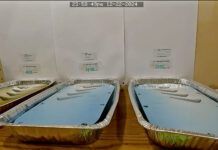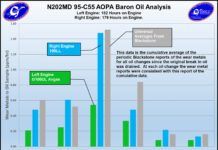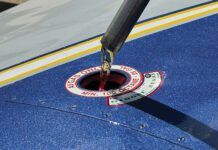While the long-awaited unleaded replacement for 100LL might not quite be ready for the fuel farm, as of early December 2013, it looked to be at least hovering over the horizon. Shell surprised the industry with a late-in-the-year announcement that it has developed an unleaded 100-octane fuel that it intends to submit to the FAA’s fuel approval process.

Shell becomes the first major oil company to submit a candidate fuel, joining two other fuels to be submitted by General Aviation Modifications, Inc. and Swift Fuel, both of whom are we’ll along in their testing of 100LL replacements. Shell’s surprise announcement was believed to be timed to coincide with ASTM International’s meeting in Tampa in early December.
The company claims its new fuel has been under development for 10 years, including test-cell research, but with minimal flying. Lycoming and Piper announced that they’re cooperating with Shell, which expects to certify its fuel within two to three years.
What Is It?
At the ASTM meeting in Tampa, Shell was cagey about the details of its new avgas, but Tim Shea, the company’s VP for aviation fuel development, told us that its fuel will be aviation-alkylate based with a blend of aromatic hydrocarbons. Conceptually, this makes it similar to GAMI’s G100UL, but a departure from Swift Fuel’s candidate, which is a binary blend of chemicals not related to traditional avgas.
Heretofore, avgas has been composed of what refiners call aviation alkylate, a blend of branched-chain hydrocarbons consisting of isomers of isooctane. Of themselves, these have high octane and good anti-knock characteristics.

But to achieve octanes of 100 and higher, refiners add a small dose of tetraethyl lead to meet the requirements of ASTM fuel spec D-910. In reality, most run-of-the-refinery avgas has motor octane values above 100.
Tetraethyl lead was banned from automotive fuels during the 1980s and there’s pressure to remove it from aviation fuels to achieve new, more stringent air-quality standards. Shea explained that in place of lead as an octane enhancer, Shell is using an aviation-alkylate base with a blend of aromatic compounds to deliver a fuel with performance characteristics almost identical to 100LL.
“In our formulation direction, we started with what aviation gasoline looks like and then removed the lead. From there, the question was how do we maintain D-910’s physical properties while achieving the MON requirement for high-octane fuel? It’s fair to say it’s alkylate-based in its approach,” Shea said.
“A lot of the chemistry has been around, but what we’ve figured out is how to make the chemistry work in an aviation fuel. A lot of the existing molecules that people are we’ll aware of struggle…with the low-temperature properties of the fuel,” Shea explained.
Indeed, the two other candidate fuels, Swift Fuel and GAMI’s G100, also rely on high aromatic content for octane and there are concerns that these fuels won’t perform as we’ll as 100LL in cold starting.
“What drove aviation fuel development was volatility as much as octane,” says BP’s Alasdair Clark, whose company is watching the Shell project closely. At the ASTM meeting, he declined to say if BP will submit its own fuel and no one else we spoke to offered any clues, either.
Although Shell’s announcement drew encouraging nods from owner groups we spoke to, within the fuels and aircraft certification communities there are open worries about how any new fuel—not just Shell’s—will compare to 100LL. ASTM D-910 defines what has become the ideal piston aviation fuel, apart from the toxic characteristics of tetraethyl lead.

But lead is such an effective—and cheap—octane enhancer that replacing it has defied industry efforts for three decades. D-910 also specifies distillation end points that define the volatility of various hydrocarbon components in gasoline. Although D-910 doesn’t define these by name, it does specify volume ranges as a means of measuring fuel volatility.
To prove those properties, Shell will undertake an intensive program that will include submission to ASTM International for a new fuel spec. Shea said the new spec will be almost identical to D-910 in performance, but will vary slightly. “In a physical property sense, we are extremely close. We meet all performance criteria and the two that we’re off, we’re off very slightly,” Shea said.
But “very slightly” is a worry for engine makers and airframers. Lycoming’s Michael Kraft says that the challenge in certifying the fuel will be to make it close enough to D-910 for the FAA to declare the fuel the technical and regulatory equivalent of 100LL.
Otherwise, the replacement fuel will need to be certified for both engines and airframes and Lycoming and Continental worry about who would do this certification work and who would pay for it. If airframers and engine makers have to fund such work, will they pass these costs on to customers and will customers pay? Shell’s fuel, and the fuel approval process in general, isn’t far enough advanced to provide a definitive answer.
Kraft said for Lycoming to certify fuel usage on its engines, it will need an ASTM spec for a basis. “We’re watching to see what Shell’s next step is with regard to ASTM. That will give us something to work with,” Kraft said. With an ASTM spec in hand, engine approvals are relatively straightforward for Lycoming, but the issue isn’t as simple as that. Hundreds of airframe models will also have to be approved and everyone in the industry is hoping the FAA will declare any new unleaded fuel the equivalent of D-910 avgas, requiring nothing but a POH entry for an approval.
What’s Next?
Shell says it will continue its testing, working with Lycoming, Piper and other companies to prove the characteristics of its unleaded fuel. At the ASTM meeting, Shell agreed to establish a task force to pursue a new ASTM spec, which the FAA says it requires within six months of the agency completing its testing.
As for the FAA’s role, it established a multi-step testing process called the Piston Aviation Fuels Initiative (PAFI) which envisions accepting up to 10 candidate fuels for initial evaluation, followed by detailed testing of just two fuels that make it through initial screening. The FAA says it’s not picking winners or losers, but only has sufficient budget for tests on two fuels.
As of December 2013, it wasn’t clear that the FAA will see additional fuel candidate submissions. Chevron, Exxon and ConocoPhillips are players in the avgas market, but sources tell us that they’re not sure if these companies will develop their own fuels or look for licensing arrangements with other refiners.
And that might happen. Said Shea: “Our plan is to make this fuel, once approved, widely available on a global basis. Whether that’s through Shell refineries or licensing, the plan is to make it available.” Shell currently doesn’t refine avgas in North America and what branded distribution it has is through exchange arrangements with other refiners. But one Shell executive told us it might consider establishing new refining in North America if the market looks promising.
We’re not sure if that will prove to be the case. Avgas volume continues to decline as flying activity decreases. The U.S. Energy Information Administration reports that the avgas market is about 225 million gallons a year and has declined from the last high in 2006 of 276 million gallons.
And what about price? “It’s a bit early stage, but our early estimates are that it will be comparable to the current leaded product,” Shea told us. “Historically, if you look where unleaded fuels have come to displace leaded fuel, the cost generally goes up a bit, but it should be within a very reasonable figure,” Shea added.
No one knows what “reasonable” means, but the best guesses we could get from industry sources are between 50 cents and $1 more than current avgas prices. But pricing will be determined by how much competition there is to refine the new fuel and what the demand will be. Shea said configuring refineries to make the new fuel is essentially an overnight process, even if the aircraft and airframe approvals to burn it might not be.
GAMI and Swift
Both GAMI and Swift continue their testing toward final approval for their fuels. GAMI’s G100UL is similar in concept to Shell’s idea, with an aviation-alkylate base and octane enhancement through blended packages of aromatic hydrocarbons.
Swift’s fuel is a binary blend of isopentane and mesitylene, derived from an acetone feedstock with a butonal co-product. It has higher heat content than avgas and is about a pound heavier per gallon than avgas.
Both companies are we’ll into testing and last fall, Swift built a pilot plant and blending site for what it hopes will become 100SF fuel. It may need the capacity; the FAA can request up to 10,000 gallons of fuel for testing purposes. Swift is pursuing a new ASTM standard specifically for its fuel.
At GAMI’s Ada, Oklahoma, headquarters, the company is continuing work on its efforts to gain STC approval for G100UL. It plans to obtain first an ASTM test spec and then either a new final spec for G100UL or perhaps approval under another new ASTM spec, according to GAMI’s Tim Roehl.
He said Embry Riddle Aeronautical University is about halfway through a 150-hour flight test program on a Cessna 182, with no issues so far. As for the impact of Shell’s submission, Roehl said, “It’s unknown what the impact is going to be. In some ways, it’s supportive of our effort. We have said there is a formulation out there that can be made that does provide 100 motor-octane performance, which is what the fleet needs in order to have a one-fuel solution.”




